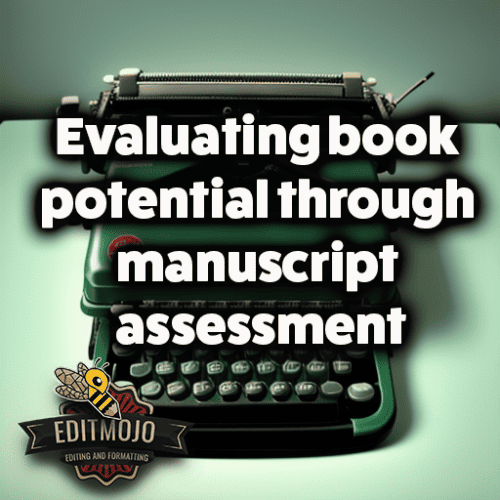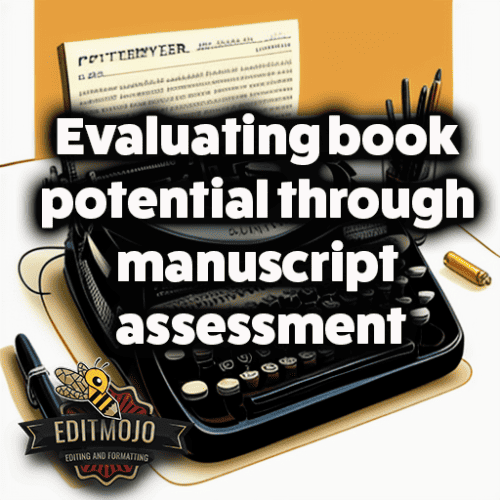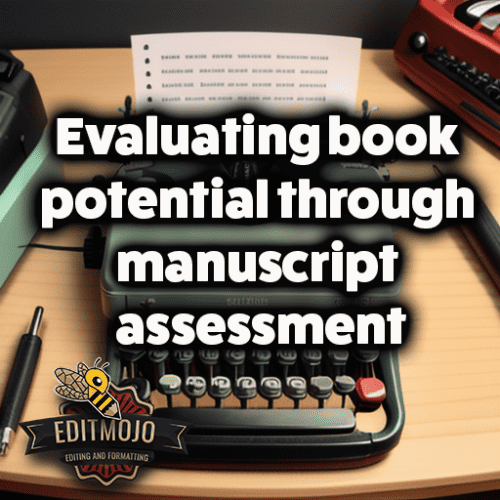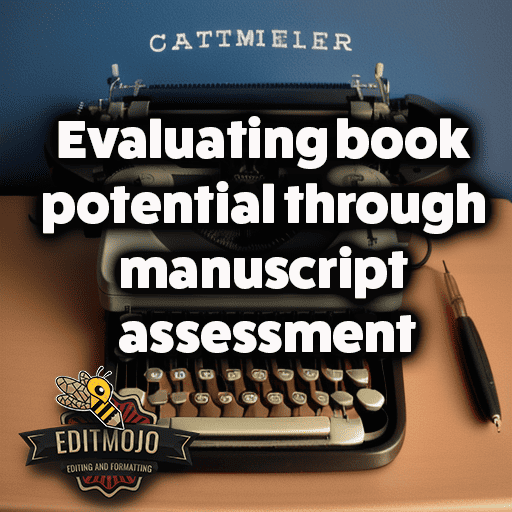Evaluating book potential through manuscript assessment
Evaluating book potential through manuscript assessment. Before an uncut diamond becomes a dazzling gem, it must be meticulously evaluated, cut, and polished. Similarly, a manuscript requires expert assessment to transform into a bestselling book. Manuscript assessment, a critical component in the publishing process, aids in discovering the diamond in the rough – the untapped potential in a draft manuscript. This post delves into the art of manuscript evaluation, the heart of bringing a book’s potential to life.
Key Takeaways
| Section | Key Points |
|---|---|
| Basics of Manuscript Assessment | Manuscript assessment involves evaluating a book manuscript’s strengths and weaknesses to provide a roadmap for improvement. |
| Manuscript Assessment Process | The process involves a systematic review of a manuscript’s elements like clarity, consistency, character development, and plot strength. |
| Elements of a Promising Manuscript | A promising manuscript features a unique plot, intriguing characters, consistent writing style, good world-building, and a well-paced narrative. |
| Enhancing Book Potential | Manuscript assessment helps identify areas for improvement, enhance strengths, and identifies a book’s target audience. |
| Commercial Potential | Assessment also considers a book’s market appeal, evaluating factors like genre trends, target audience, and marketability. |
| Assessment Tools and Resources | Tools like professional manuscript assessment services, self-assessment techniques, and software aid in manuscript assessment. |
| Post-Assessment Revision | Understanding feedback and revising accordingly is crucial after manuscript assessment. |
| Successful Manuscripts Post-Assessment | Manuscripts like “Harry Potter and the Philosopher’s Stone” transformed significantly due to thorough assessments and revisions. |
Understanding the Basics of Manuscript Assessment
Manuscript assessment, or critique, refers to a process where a manuscript evaluator or assessor conducts a thorough examination of a book manuscript. This comprehensive critique helps identify strengths and weaknesses, providing a roadmap for improvement.
Importantly, a manuscript assessor is not an editor or a proofreader. While these roles intersect, they serve different purposes. An editor refines a manuscript by focusing on structure, style, and content. A proofreader corrects errors in grammar, punctuation, and spelling. On the other hand, a manuscript assessor gives an impartial evaluation of the entire manuscript’s potential, from content and style to marketability.
The Manuscript Assessment Process
Manuscript assessment is a thorough process involving a systematic review of each manuscript element. Assessors evaluate a manuscript’s clarity, consistency, character development, and plot strength.
In this process, it’s crucial to understand the book’s genre. For example, an assessor would look for different elements in a fantasy novel (magical realism, world-building) compared to a thriller (plot twists, suspense). This is akin to how one would judge a delicate pastel watercolor differently from a vibrant oil painting – both beautiful, but with unique characteristics and appeal.

Unpacking the Elements of a Promising Manuscript
Imagine walking into a house. The exterior is unassuming, but as you step inside, you find a layout that flows harmoniously, filled with intriguing details that catch your eye. This is the magic a promising manuscript can hold. Some key elements include:
- Unique and Compelling Plot Development: A gripping plot is like a heart that pumps life into a manuscript. A predictable plot is akin to a flatline, while an unexpected plot twist could be a adrenaline rush – it’s all about keeping the reader’s pulse racing.
- Intriguing Character Development and Dynamics: Characters are the soul of a story. Readers should connect with them, experiencing their joys, fears, and growth. A well-developed character is not unlike meeting a fascinating stranger – they should pique your curiosity and linger in your thoughts long after you’ve parted.
- Consistency in Writing Style and Voice: A writer’s style and voice are the unique fingerprints they leave on a manuscript. A consistent voice is like the rhythm in a song – it holds everything together and sets the tone for the reader’s experience.
- Adequate World-Building (for certain genres): For genres like fantasy and science fiction, world-building can transport readers into a new reality. Good world-building is akin to a meticulously planned vacation – every detail enhances the immersive experience.
- Well-Paced Narrative Structure: A well-paced narrative ensures that readers are neither overwhelmed nor bored. It’s like a scenic drive, where the speed allows you to appreciate the view, feel the thrill, but never lose control.
The Role of Manuscript Assessment in Enhancing a Book’s Potential
Manuscript assessment helps an author to see their work from a fresh perspective. Constructive criticism, when done right, is like a personal trainer – it pushes you to overcome weaknesses, enhance strengths, and
ultimately, reach your potential.
Moreover, assessment often helps identify a book’s target audience. It’s like a compass, pointing towards those who would resonate most with the book’s journey.

The Market Perspective: Assessing Commercial Potential
Apart from literary merit, a manuscript assessment also considers the book’s commercial potential. Factors such as current genre trends, target audience, and overall marketability come into play. It’s like planning a restaurant menu – it’s not just about cooking delicious food, but also what your customers would love to eat.
Balancing artistic expression with market considerations can be a challenging feat, but it’s a reality in the publishing industry. Just as Vincent Van Gogh famously said, “What would life be if we had no courage to attempt anything?”, taking creative risks can sometimes lead to surprising successes.
Manuscript Assessment Tools and Resources
Professional manuscript assessment services, self-assessment techniques for authors, and software like AutoCrit and ProWritingAid can aid in manuscript evaluation. Beta readers and writing critique groups can also provide invaluable feedback. It’s like having a dedicated team, each offering different skills and perspectives, united towards crafting a masterpiece.
Navigating Feedback and Revision after Manuscript Assessment
Post-assessment, interpreting feedback is an art in itself. It’s like panning for gold – one must learn to distinguish between the valuable nuggets of insight and the distracting rubble of subjective opinions.
Moreover, revisions are not just about rectifying errors but embracing the chance to refine and enhance your work. It’s like a sculptor chiseling away at a marble block – each revision brings you closer to the final, stunning creation.

Case Studies: Manuscripts that Transformed Post-Assessment
A striking example is J.K. Rowling’s “Harry Potter and the Philosopher’s Stone,” which underwent numerous revisions and assessments before blooming into the sensation it is today. The initial manuscript faced many rejections, but Rowling’s resilience and the invaluable feedback from early assessors shaped a generation-defining series.
Conclusion (Evaluating book potential through manuscript assessment)
Evaluating a book’s potential through manuscript assessment is an enriching journey. It unearths hidden gems, polishes rough edges, and brings forth the unique beauty of a manuscript. It requires patience, persistence, and a keen eye for detail, but the reward – a truly captivating book – is worth every effort.
References and Further Reading
For more insights into manuscript assessment, explore resources like The Creative Penn and The Book Designer. Consider reaching out to professional services like Reedsy, who offer expert manuscript assessment.
This post has strived to demystify manuscript assessment, but the journey is always ongoing. Have more questions? Curious about a specific aspect of manuscript assessment? Feel free to keep the conversation going in the comments below.
Remember, manuscript assessment is not just about evaluating a manuscript’s potential – it’s about nurturing it, one revision at a time.
Top Five Q&A (Evaluating book potential through manuscript assessment)
- What is manuscript assessment?
- Manuscript assessment is a comprehensive critique of a manuscript to identify its strengths and weaknesses. This process provides an impartial evaluation of a manuscript’s potential, considering aspects like content, style, and marketability.
- Why is manuscript assessment important?
- Manuscript assessment is crucial as it provides a roadmap for improvement. It identifies areas that need refinement, aids in understanding a book’s potential, helps identify the target audience, and evaluates the book’s market appeal.
- What elements make a promising manuscript?
- Key elements of a promising manuscript include a unique and compelling plot, intriguing character development, consistency in writing style, sufficient world-building for certain genres, and a well-paced narrative structure.
- What are some resources for manuscript assessment?
- Resources for manuscript assessment range from professional manuscript assessment services to self-assessment techniques for authors. Software like AutoCrit and ProWritingAid and input from beta readers and writing critique groups can also be invaluable.
- How do authors handle feedback after manuscript assessment?
- Authors should interpret feedback constructively, distinguishing between valuable insights and subjective opinions. They should embrace revisions not just to rectify errors but to refine and enhance their work.
